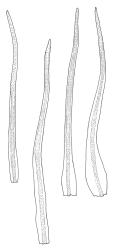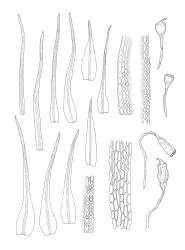Plants light green to blue-green, erect, pale and rather shiny, loosely gregarious. Stems erect, simple, c. 0.5–1.5 mm, usually several arising from a common base. Leaves wiry, stiffly flexuose-erect to flexuose-twisted when dry, flexuose-erect when moist, (0.2–)1.0–2.2 × c. 0.05–0.10 mm, setaceous, not or scarcely widened at base, entire to slightly crenulate at margins, not sheathing; mid laminal cells clear and unistratose, in 1 or 2 rows beside the costa, rectangular or ± quadrate, (8–)10–26(–30) × 4–8 µm, smooth; lower laminal cells often slightly longer, but not otherwise differentiated; basal and alar cells not differentiated or slightly enlarged, not forming distinct groups. Costa narrow, weak below, somewhat wider above, ending in or a few cells below the apex, not filling the upper part of leaf.
Autoicous. Perichaetial leaves distinctly shorter than vegetative, c. 1.0–1.5 mm, lanceolate to ovate-lanceolate, shortly subulate, with laminal cells to 80 µm. Perigonia terminal on male shoots which arise from base of perichaetial shoots. Setae 0.8–1.2(–1.5) mm (excluding the vaginula), straight or slightly curved when moist, erect and twisted strongly to the right when dry; capsules exserted, turbinate and widest at the mouth when dry, obovate-hemispheric when moist, gradually contracted to the setae, smooth, erect, symmetric, 0.3–0.5(–0.6) mm, with a short and immersed columella; exothecial cells irregular to ± rhombic, ± evenly thin-walled, with rounded-subquadrate and somewhat darker cells at mouth; annulus not differentiated; stomata as per genus; operculum obliquely rostrate from a plano-convex base, c. 0.3–0.5 mm, not systylious, often falling with the calyptra. Peristome of 16 moderately short, reddish, rounded or truncate teeth (the fragile tips often falling with the operculum), smooth except for thickened transverse walls on outer surface, smooth on inner surface, inserted at the mouth and extending c. 120–180 µm beyond rim. Spores (10–)12–15 µm, ± smooth, green.
Seligeria cardotii is easily differentiated from the much rarer S. diminuta by its straight or slightly curved setae, setaceous leaves that are not or scarcely widened at the base, and its pale gametophytes. Microscopic characters, such as the nature of the laminal cells and spore diameters, also help to differentiate these two indigenous species. Sterile material is rarely, if ever, collected, but could possibly be confused with smaller forms of Ditrichum spp.
NI: S Auckland (Piopio), Gisborne (Rosie Bay at Lake Waikaremoana), Wellington (Okupata Stream, NW Ruahine Range); SI: Nelson (Rockville, Tākaka Hill, Fenian Creek, Cobb Valley, Mt Arthur Range, Fyfe River, Fox River, Punakaikī, Mt Owen Range, near Reefton), Marlborough (Gorge Creek, Waima River, Clinton River), Canterbury (Waipara Gorge, Broken River basin including Castle Hill), Southland (Lake Orbell, Borland Burn, Pig Creek); Ch (Te Whanga).
Australasian. Recorded from Tasmania by Dalton (1995, 1998).
Seligeria cardotii is not uncommon on sheltered and weathered limestone and marble; it is collected most frequently on vertical rock walls and beneath over-hangs. At Dry Rock Shelter on the Mt Arthur Range this species formed colonies of c. 1 × 0.3 m on limestone that was probably subject to some irrigation following heavy rains. It grows abundantly on the deeply shaded undersurface of massive limestone blocks overhanging flowing water (possibly immersed in floods) in the gorges of the Porter River (Broken River basin). This species is found in various vegetation types, including broad-leaved and southern beech forest, scrubland, grassland, or alpine vegetation. Gymnostomum calcareum is the most frequent close associate. Near the type locality at Castle Hill, it is found at the base of limestone cliffs growing with the much rarer Seligeria diminuta and close to Encalypta rhaptocarpa, Gymnostomum calcareum, Orthotrichum cupulatum, and Syntrichia phaea. At other sites, loosely associated species include Anoectangium bellii, Eucladium irroratum, Meesia uliginosa, and Palamocladium leskeoides (the last at Piopio and the Cobb Valley). At Lake Orbell in Southland L.D. S. cardotii occurred in intimate association with an extensive growth (c. 1 m2) of Blindia magellanica (the only species of Blindia in N.Z. that sometimes occurs on calcareous rock) on moist, shaded south-facing limestone cliffs. Vitt & Bartlett (1983) recorded it from "sloping rock surface with B. magellanica" from near Reefton (Nelson L.D.). Occurring between elevations of near sea level (as at Punakaikī) and at least 1500 m (Mt Arthur Range).
Seligeria cardotii is distinguished by its pale, bluish green coloration and linear vegetative leaves, with median laminal cells (limited to one to two rows beside the costa) mostly longer than wide. The capsule is hemispheric, becoming obconic to turbinate with age. The setae are short (but long enough for the capsule to be exserted) and straight or somewhat flexuose, with little or no curvature. The spores are 10–15 µm diam, (which is small for the genus fide Vitt & Bartlett 1983).
The peristome teeth are nearly always truncate or rounded, and often extend to c. 180 µm beyond the rim. Intact peristome teeth are rare in herbarium material, as the tips generally break off and fall with the operculum. In older capsules peristome teeth are mostly unobservable. The intact peristome teeth were described as "lanceolate" by Vitt & Bartlett (1983).
Vitt & Bartlett (1983) suggest that S. cardotii is morphologically most similar to the northern hemisphere S. pusilla in the subgenus Seligeria (Vitt 1976) by virtue of its small spore size, straight setae, and light green, delicate gametophytes with relatively long and clear median leaf cells, narrow costa, and linear leaves.










